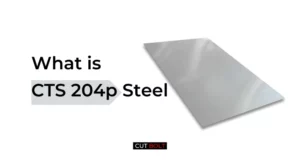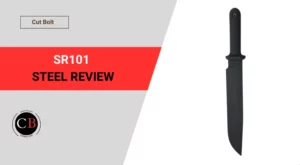Probably you have already heard about AISI 1095 steel. But is 1095 steel good for knives? Well, I was researching to find how good is 1095 steel for making a knife.
If you want to know more about this steel, such as what its chemical composition is, its hardness, and its suitability as a knife steel. Read my 1095 steel review in this post.
Table of Contents
What is AISI 1095 steel?
AISI 1095 steel is an “old” high-carbon steel from the 10XX steel series, generally used for knives and blades. The first two digits of the designation “1095” refer to the two main elements used in the steel, while the last two digits represent the average percentage of carbon used.
In the case of “1095”, the first digit, “1”, refers to carbon, the second digit “0” means that there is no second main element used in the alloy, as the last two digits, the 9 and the 5, refer to 0.95%, which means that the steel has a carbon content of 0.95%.
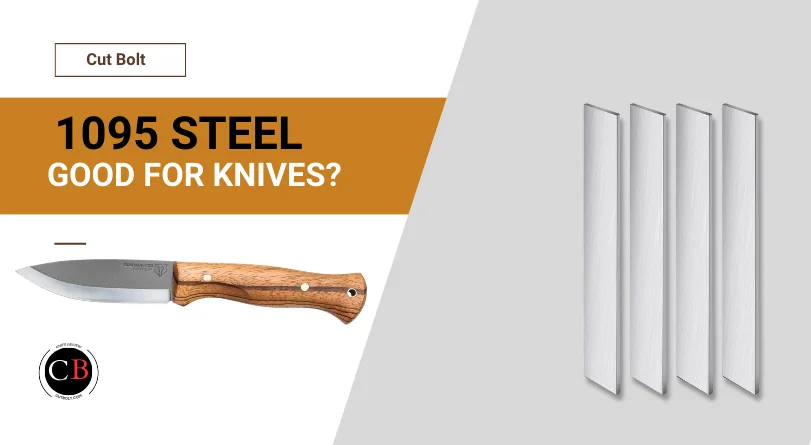
1095 steel chemical composition
| Element | Portion | Effect |
| Carbon | 0.95% | Increasing hardness and tensile strength. In larger quantities, increase in brittleness and reduction in forgeability and weldability. |
| Manganese | 0.5% | Improves hardness and tensile strength. |
| Phosphorus | 0.03% | Increases tensile strength, hardness and corrosion resistance but also brittleness. |
| Sulfur | 0.05% | Increases machinability but also brittleness. |
As you can see, 1095 is mainly composed of carbon and manganese, which makes it a very hard steel.
Is AISI 1095 a tool steel?
AISI 1095 is a tool steel with a comparatively high carbon content. The term tool steel is commonly used for steels with a carbon content of 0.5% or more. In general, however, tool steel has a carbon content well above 1%, which significantly changes the behavior of the steel.
Is AISI 1095 rustproof or stainless steel?
AISI 1095 steel is neither rust-free steel nor stainless steel. To be considered rustproof it should have a chromium content of at least 10.5-13% dissolved in the austenite or ferrite (see here). It is not stainless steel either, because its sulfur and phosphorus content (so-called iron companions) exceeds 0.025% (see here).
What is the hardness (HRC) of 1095 knife steel?
The hardness of 1095 steel typically ranges from 55 to 58 HRC (Rockwell Hardness Scale) when properly heat-treated. The specific hardness can vary based on the heat treatment process applied by the manufacturer and the intended application of the steel. Here you can learn about the 1095 steel heat treatment process.
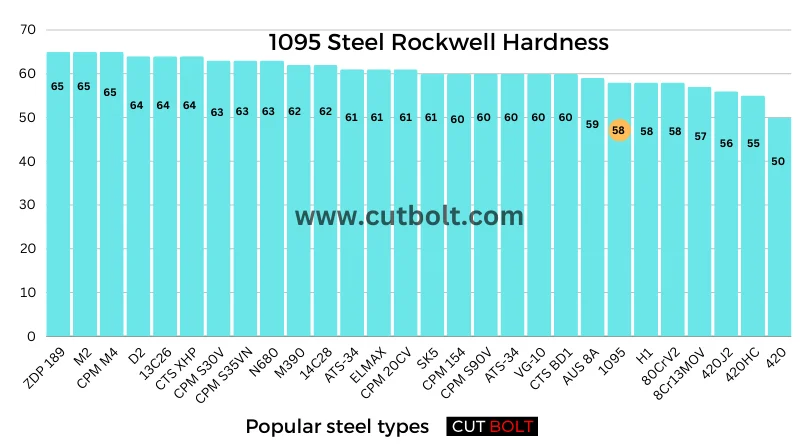
Properties of AISI 1095 steel
According to the chemical composition and hardness of AISI 1095 steel, it offers the following properties and characteristics:
- Edge retention: it is a hard steel AISI 1095, which offers a high strength of the cutting edge thanks to the mixture of carbon and manganese used in the alloy. This means its edge retention is good, it is in the upper middle range.
- Corrosion resistance: The corrosion resistance of AISI 1095 is low because there is no chromium in the alloy. In other words, 1095 is a very corrosion-prone steel that will rust very quickly.
- Wear resistance: AISI 1095 is hard and offers good wear resistance. It still needs to be topped, but it is sufficient for outdoor use.
- Sharpness: AISI 1095 is relatively easy to sharpen, still with normal grinding stones. Note: the harder the steel, the more demanding it is to sharpen. The limit where a steel can still be sharpened with conventional whetstones and when you need a diamond whetstone is at 60 HRC. For knives below that, a conventional whetstone is sufficient, and above 60HRC it becomes tough.
- Machinability: 1095 steel is considered difficult to machine due to its high carbon content (0.95% carbon). The high hardness level achieved through heat treatment also contributes to poor machinability.
- Toughness: The toughness of AISI 1095 knife steel is good, but this can decrease at the expense of hardness – 1095 can theoretically be hardened to 63 HRC, but the steel will then be brittle.
Is AISI 1095 steel a good knife steel?
AISI 1095 is a popular knife steel that has been around for a very long time. Its heat treatment is easy, its toughness is good, and it can achieve high hardness with excellent edge retention while not being expensive.
All this makes it a great steel for knife making, especially for beginners. The steel is user-friendly, easy to sharpen, and easy to harden – from moderate to ultra-hard (but then brittle).
AISI 1095 is certainly not the PERFECT steel for knife making, because there is no such thing as a “perfect steel”. It always depends on the application and the environment in which a knife is to be used to find the perfect steel. However, 1095 has its place in the “club of good steels for knife making”.
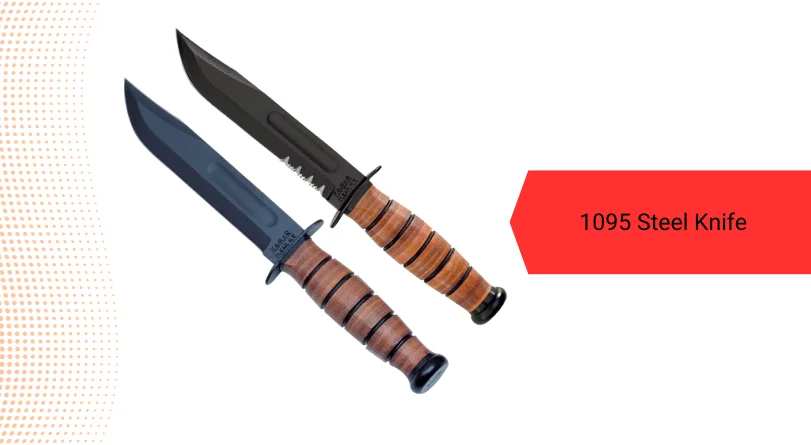
AISI 1095 steel equivalents
Within the 10xx series, AISI 1084 is a steel very similar to AISI 1095. Except for silicon (1084 contains more silicon), both have an almost identical chemical composition. With both steels, it is possible to produce a cutting edge with good strength, good hardness and great wear resistance.
Unfortunately, both steels have poor corrosion resistance and they are about the same price. Either of these steels is well suited for beginners who want to take their first steps into the knifemaking craft, as the process of heating and tempering is quite simple with them.
AISI 1095 vs. AISI 1084 steel
In this section, we compare 1095 and 1084 in four criteria: Edge retention, corrosion resistance, ease of sharpening and toughness, on a scale of 1 to 10.
| Criteria | 1095 | 1084 |
| Edge retention | 5/10 | 4/10 |
| Simplicity of sharpening | 7/10 | 3/10 |
| Corrosion resistance | 2/10 | 3/10 |
| Toughness | 7/10 | 3/10 |
As you can see, AISI 1095 offers comparable performance to AISI 1084 in terms of edge retention and corrosion resistance, with 1095 coming out on top in terms of edge retention and 1084 coming out on top in terms of corrosion resistance.
Few points that will help you understand differences between 1084 steel and 1095 steel:
- 1095 steel has 0.95% carbon while 1084 has 0.84% carbon. This small extra bit of carbon makes a significant difference.
- The higher carbon content in 1095 improves corrosion resistance and edge retention but makes the steel harder to sharpen.
- The additional carbon also makes 1095 less tolerant to faults during heat treatment compared to 1084.
- As such, 1084 steel is more forgiving and better suited for beginners at heat treatment.
- For heat treating 1095 steel, temperatures must remain precisely at 800°C, versus a wider range of 780-850°C for 1084.
- When annealing or applying other heat treatments that don’t require quenching, 1084 steel can be cooled down from above the critical temperature at almost any rate. However, when heat treating 1095 steel, it’s best to avoid cooling the steel more slowly than air cooling.
Keep in mind:
Final words: Is 1095 Steel Good for Knives?
Owning a 1095 steel knife is exceedingly popular, as this steel has been around for a long time, and many big names in the knife industry have a “1095 knife” on the market.
And honestly, despite its corrosion resistance, it’s a great steel for all types of knives, from EDCs to fixed-blade knives. All you have to do is care for it a bit – nothing dramatic – clean it after use, oil it occasionally, remove rust when necessary, and you will get years of enjoyment out of an AISI 1095 steel knife.

